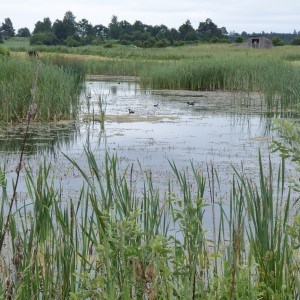Contact
Department of Aquatic Sciences and Assessment, Division of Geochemistry and Hydrology

LEAF-PAD aims to understand how small, artificial waterbodies (ponds and ditches) contribute to greenhouse gas emissions and carbon storage, on scales ranging from local to global.
Inland waters (lakes, reservoirs, streams, rivers) are important components of the global carbon cycle. They can act as sinks and sources of the greenhouse gases carbon dioxide, methane and nitrous oxide, and therefore need to be accounted for in global greenhouse gas budgets.
Recent research has shown that greenhouse gas emissions from ditches and ponds can be large. Although these waterbodies are small, in some areas they can be numerous, and therefore they might be important for landscape-scale carbon storage and greenhouse gas emissions. However, at present there is a lack of data from these small waterbodies. LEAF-PAD aims to address this knowledge gap.
LEAF-PAD is a four-year project and incorporates several work packages with different aims.
The global component of LEAF-PAD involves collaborators across the world using standardised methods to measure emissions of greenhouse gases from ponds and ditches once during summer and once during winter. This will give a broad overview of greenhouse gas emissions from these waterbodies in different climate zones and land uses, and provide an indication of seasonal differences.
More intensive fieldwork will be undertaken in Uppsala County, with repeated measurements of greenhouse gases and carbon storage being made for several years in a range of ditches and ponds across different land uses (urban, forestry, agricultural). This will allow the effect of land use on greenhouse gas emissions to be determined and will show if and how emissions vary throughout the year.
Another work package will involve sediment cores being collected from ditches and ponds and returned to the laboratory, where controlled experiments will aim to untangle how nutrient additions and drought/rewetting cycles affect greenhouse gases.
Finally, a synthesis work package will bring the project findings together. This synthesis will be used to develop a simple process model to simulate greenhouse gas emissions from artificial waterbodies. In turn, this will be used to deliver recommendations on how greenhouse gas emissions from these waterbodies can be reduced.
LEAF-PAD is funded by Formas and led by Mike Peacock. Also involved at SLU are Martyn Futter, Chris Evans, and Pia Geranmayeh.
Global importance of methane emissions from drainage ditches and canals, Peacock et al., 2021
Small artificial waterbodies are widespread and persistent emitters of methane and carbon dioxide, Peacock et al., 2021